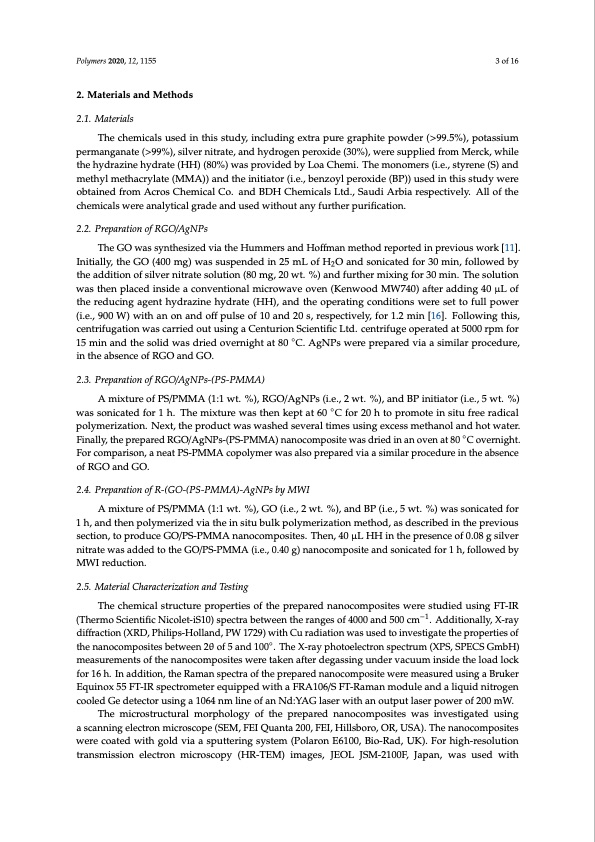
PDF Publication Title:
Text from PDF Page: 003
Polymers 2020, 12, 1155 3 of 16 2. Materials and Methods 2.1. Materials The chemicals used in this study, including extra pure graphite powder (>99.5%), potassium permanganate (>99%), silver nitrate, and hydrogen peroxide (30%), were supplied from Merck, while the hydrazine hydrate (HH) (80%) was provided by Loa Chemi. The monomers (i.e., styrene (S) and methyl methacrylate (MMA)) and the initiator (i.e., benzoyl peroxide (BP)) used in this study were obtained from Acros Chemical Co. and BDH Chemicals Ltd., Saudi Arbia respectively. All of the chemicals were analytical grade and used without any further purification. 2.2. Preparation of RGO/AgNPs The GO was synthesized via the Hummers and Hoffman method reported in previous work [11]. Initially, the GO (400 mg) was suspended in 25 mL of H2O and sonicated for 30 min, followed by the addition of silver nitrate solution (80 mg, 20 wt. %) and further mixing for 30 min. The solution was then placed inside a conventional microwave oven (Kenwood MW740) after adding 40 μL of the reducing agent hydrazine hydrate (HH), and the operating conditions were set to full power (i.e., 900 W) with an on and off pulse of 10 and 20 s, respectively, for 1.2 min [16]. Following this, centrifugation was carried out using a Centurion Scientific Ltd. centrifuge operated at 5000 rpm for 15 min and the solid was dried overnight at 80 ◦C. AgNPs were prepared via a similar procedure, in the absence of RGO and GO. 2.3. Preparation of RGO/AgNPs-(PS-PMMA) A mixture of PS/PMMA (1:1 wt. %), RGO/AgNPs (i.e., 2 wt. %), and BP initiator (i.e., 5 wt. %) was sonicated for 1 h. The mixture was then kept at 60 ◦C for 20 h to promote in situ free radical polymerization. Next, the product was washed several times using excess methanol and hot water. Finally, the prepared RGO/AgNPs-(PS-PMMA) nanocomposite was dried in an oven at 80 ◦C overnight. For comparison, a neat PS-PMMA copolymer was also prepared via a similar procedure in the absence of RGO and GO. 2.4. Preparation of R-(GO-(PS-PMMA)-AgNPs by MWI A mixture of PS/PMMA (1:1 wt. %), GO (i.e., 2 wt. %), and BP (i.e., 5 wt. %) was sonicated for 1 h, and then polymerized via the in situ bulk polymerization method, as described in the previous section, to produce GO/PS-PMMA nanocomposites. Then, 40 μL HH in the presence of 0.08 g silver nitrate was added to the GO/PS-PMMA (i.e., 0.40 g) nanocomposite and sonicated for 1 h, followed by MWI reduction. 2.5. Material Characterization and Testing The chemical structure properties of the prepared nanocomposites were studied using FT-IR (Thermo Scientific Nicolet-iS10) spectra between the ranges of 4000 and 500 cm−1. Additionally, X-ray diffraction (XRD, Philips-Holland, PW 1729) with Cu radiation was used to investigate the properties of the nanocomposites between 2θ of 5 and 100◦. The X-ray photoelectron spectrum (XPS, SPECS GmbH) measurements of the nanocomposites were taken after degassing under vacuum inside the load lock for 16 h. In addition, the Raman spectra of the prepared nanocomposite were measured using a Bruker Equinox 55 FT-IR spectrometer equipped with a FRA106/S FT-Raman module and a liquid nitrogen cooled Ge detector using a 1064 nm line of an Nd:YAG laser with an output laser power of 200 mW. The microstructural morphology of the prepared nanocomposites was investigated using a scanning electron microscope (SEM, FEI Quanta 200, FEI, Hillsboro, OR, USA). The nanocomposites were coated with gold via a sputtering system (Polaron E6100, Bio-Rad, UK). For high-resolution transmission electron microscopy (HR-TEM) images, JEOL JSM-2100F, Japan, was used withPDF Image | Microwave Irradiation Synthesis Silver Nanoparticle

PDF Search Title:
Microwave Irradiation Synthesis Silver NanoparticleOriginal File Name Searched:
polymers-12-01155-v2.pdfDIY PDF Search: Google It | Yahoo | Bing
Turbine and System Plans CAD CAM: Special for this month, any plans are $10,000 for complete Cad/Cam blueprints. License is for one build. Try before you buy a production license. More Info
Waste Heat Power Technology: Organic Rankine Cycle uses waste heat to make electricity, shaft horsepower and cooling. More Info
All Turbine and System Products: Infinity Turbine ORD systems, turbine generator sets, build plans and more to use your waste heat from 30C to 100C. More Info
CO2 Phase Change Demonstrator: CO2 goes supercritical at 30 C. This is a experimental platform which you can use to demonstrate phase change with low heat. Includes integration area for small CO2 turbine, static generator, and more. This can also be used for a GTL Gas to Liquids experimental platform. More Info
Introducing the Infinity Turbine Products Infinity Turbine develops and builds systems for making power from waste heat. It also is working on innovative strategies for storing, making, and deploying energy. More Info
Need Strategy? Use our Consulting and analyst services Infinity Turbine LLC is pleased to announce its consulting and analyst services. We have worked in the renewable energy industry as a researcher, developing sales and markets, along with may inventions and innovations. More Info
Made in USA with Global Energy Millennial Web Engine These pages were made with the Global Energy Web PDF Engine using Filemaker (Claris) software.
Infinity Turbine Developing Spinning Disc Reactor SDR or Spinning Disc Reactors reduce processing time for liquid production of Silver Nanoparticles.
| CONTACT TEL: 608-238-6001 Email: greg@infinityturbine.com | RSS | AMP |